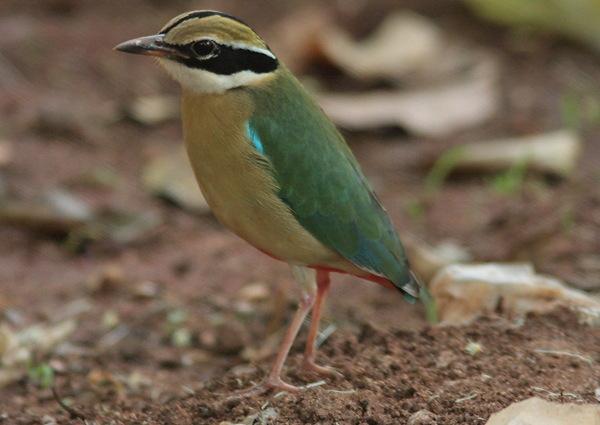Of the
twenty-four illustrations
contributed by Edward Buckley to John Ray's
"Synopsis Methodica Avium
et Piscium", the first one whose identity is not reasonably obvious
is the "Madrass Jay", in the bottom left corner. From the illustration,
I guessed that it was a Brahminy Myna, but a glance at the description
showed that it could only be an Indian Pitta Pitta brachyura.
I wrote to the
delhibirdpix list
to ask for photographs of an Indian Pitta to post on this web page, and
once again, Sharad Sridhar sent me a selection of photos (including one
from Tamil Nadu, although the one below is from Karnataka).

Here is Buckley's description, followed by my translation:
12. Pica Indica vulgaris: Ponnunky Pitta; Gent.
Ponnandutty; Maderaspatensibus : The MADRASS-JAY.
Fig 10. Nostrati Picae glandariae affinis est. Linea
arcuata albida supra oculos. Alarum tegetes virescunt,
Scapis flavescentibus: juxta basin alarum macula coerulea:
Remiges & Cauda nigrescunt: Uropygium coeruleo maculatur:
inter femora usque ad caudam rubescit.
The "Ponnunky Pitta" above is another rendition of "Ponnangi pitta", the
Telugu name for the Indian Pitta. We are fortunate that Buckley thought
these names worth recording, although they are not given for all of the
species he describes.
Then he says: it is "related to our Picae glandariae [Jays]",
and has a "curved pale line above the eye" ("arcuata" means bow-shaped,
as in the beak of the Curlew Numenius arquata. Note that the more
brightly-coloured Blue-banded Pitta is named Pitta arcuata). The
"upper wings are greenish, with the feather shafts turning yellow", and
"near the base of the wing is a blue spot". The "flight feathers and
tail become black", the "rump has blue spots" (Uropygium being from the
Greek word for rump), and it "becomes red from between the thighs upto
the tail".
The Pica glandaria that Buckley thought the Pitta was related to
is the
Eurasian Jay,
now Garrulus glandarius (which is itself
described by Ray
in the main part of the book). I don't see any reason why he might have
inferred such a relationship (the birds certainly don't look similar),
but the Jay is mentioned in many of his other descriptions too.
The distinction between the colour of the upperwing feathers and their
shafts (as well as the blue spots on the rump, not ordinarily visible)
shows that the description was based on a specimen in the hand. Since
this was written in the seventeenth century, less than a hundred years
after the invention of the telescope, the good Doctor Buckley is quite
unlikely to have observed these details through a handy pair of Nikon
binoculars.
Another interesting aspect (also seen in the earlier description of the
Painted Snipe is the tendency to
describe changes in colour rather than colours in isolation. The wing
feathers "turn green", and the flight feathers "turn black", and so on.
I don't know if this was a general convention at that time, but Ray's
(generally much more detailed) descriptions earlier in the book do not
appear to use it often.
Anyway, the description together with the vernacular name allow us to
unambiguously identify the species involved.
Feedback is welcome, especially towards improving the translation.